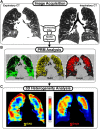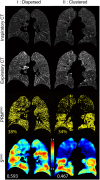CT-Based Local Distribution Metric Improves Characterization of COPD
- PMID: 28592874
- PMCID: PMC5462827
- DOI: 10.1038/s41598-017-02871-1
CT-Based Local Distribution Metric Improves Characterization of COPD
Abstract
Parametric response mapping (PRM) of paired CT lung images has been shown to improve the phenotyping of COPD by allowing for the visualization and quantification of non-emphysematous air trapping component, referred to as functional small airways disease (fSAD). Although promising, large variability in the standard method for analyzing PRMfSAD has been observed. We postulate that representing the 3D PRMfSAD data as a single scalar quantity (relative volume of PRMfSAD) oversimplifies the original 3D data, limiting its potential to detect the subtle progression of COPD as well as varying subtypes. In this study, we propose a new approach to analyze PRM. Based on topological techniques, we generate 3D maps of local topological features from 3D PRMfSAD classification maps. We found that the surface area of fSAD (SfSAD) was the most robust and significant independent indicator of clinically meaningful measures of COPD. We also confirmed by micro-CT of human lung specimens that structural differences are associated with unique SfSAD patterns, and demonstrated longitudinal feature alterations occurred with worsening pulmonary function independent of an increase in disease extent. These findings suggest that our technique captures additional COPD characteristics, which may provide important opportunities for improved diagnosis of COPD patients.
Conflict of interest statement
E.P. has received an unrestricted educational grant for research from Astra Zeneca and Chiesi; fees for consultancies by E.P. were given to the University of Groningen by A.Z., Boehringer Ingelheim, Chiesi, G.S.K., Nycomed and TEVA. N.H.T.t.H. received grants from GlaxoSmithKline, Boehringer Ingelheim, Nycomed and Chiesi. C.J.G., B.D.R. and B.A.H. have a financial interest in the underlying patented University of Michigan technology licensed to Imbio, L.L.C., a company in which B.D.R. has a financial interest. S.G., P.A.d.J., F.A.A.M.H., L.K., T.D.J., and M.v.d.B. have no competing interests.
Figures





Similar articles
-
Topologic Parametric Response Mapping Identifies Tissue Subtypes Associated with Emphysema Progression.Acad Radiol. 2024 Mar;31(3):1148-1159. doi: 10.1016/j.acra.2023.08.003. Epub 2023 Sep 2. Acad Radiol. 2024. PMID: 37661554 Free PMC article.
-
Parametric response mapping monitors temporal changes on lung CT scans in the subpopulations and intermediate outcome measures in COPD Study (SPIROMICS).Acad Radiol. 2015 Feb;22(2):186-94. doi: 10.1016/j.acra.2014.08.015. Epub 2014 Nov 4. Acad Radiol. 2015. PMID: 25442794 Free PMC article.
-
Parametric response mapping on chest computed tomography associates with clinical and functional parameters in chronic obstructive pulmonary disease.Respir Med. 2017 Feb;123:48-55. doi: 10.1016/j.rmed.2016.11.021. Epub 2016 Nov 25. Respir Med. 2017. PMID: 28137496 Free PMC article.
-
Morphological and functional imaging in COPD with CT and MRI: present and future.Eur Radiol. 2008 Mar;18(3):510-21. doi: 10.1007/s00330-007-0772-1. Epub 2007 Sep 27. Eur Radiol. 2008. PMID: 17899100 Review.
-
Quantitative computed tomography in COPD: possibilities and limitations.Lung. 2012 Apr;190(2):133-45. doi: 10.1007/s00408-011-9353-9. Epub 2011 Dec 17. Lung. 2012. PMID: 22179694 Free PMC article. Review.
Cited by
-
Local heterogeneity of normal lung parenchyma and small airways disease are associated with COPD severity and progression.Respir Res. 2024 Feb 28;25(1):106. doi: 10.1186/s12931-024-02729-x. Respir Res. 2024. PMID: 38419014 Free PMC article.
-
Topologic Parametric Response Mapping Identifies Tissue Subtypes Associated with Emphysema Progression.Acad Radiol. 2024 Mar;31(3):1148-1159. doi: 10.1016/j.acra.2023.08.003. Epub 2023 Sep 2. Acad Radiol. 2024. PMID: 37661554 Free PMC article.
-
Quantitative CT Characteristics of Cluster Phenotypes in the Severe Asthma Research Program Cohorts.Radiology. 2022 Aug;304(2):450-459. doi: 10.1148/radiol.210363. Epub 2022 Apr 26. Radiology. 2022. PMID: 35471111 Free PMC article.
-
Gene expression profiling of bronchial brushes is associated with the level of emphysema measured by computed tomography-based parametric response mapping.Am J Physiol Lung Cell Mol Physiol. 2020 Jun 1;318(6):L1222-L1228. doi: 10.1152/ajplung.00051.2020. Epub 2020 Apr 22. Am J Physiol Lung Cell Mol Physiol. 2020. PMID: 32320267 Free PMC article.
-
Role of visual assessment of chronic obstructive pulmonary disease on chest CT: beauty is in the eye of the beholder.J Thorac Dis. 2021 Dec;13(12):6936-6939. doi: 10.21037/jtd-21-1527. J Thorac Dis. 2021. PMID: 35070377 Free PMC article. No abstract available.
References
-
- Pike, D. et al. Regional Heterogeneity of Chronic Obstructive Pulmonary Disease Phenotypes: Pulmonary He Magnetic Resonance Imaging and Computed Tomography. COPD 1–9 (2016). - PubMed
Publication types
MeSH terms
Grants and funding
LinkOut - more resources
Full Text Sources
Other Literature Sources
Medical

